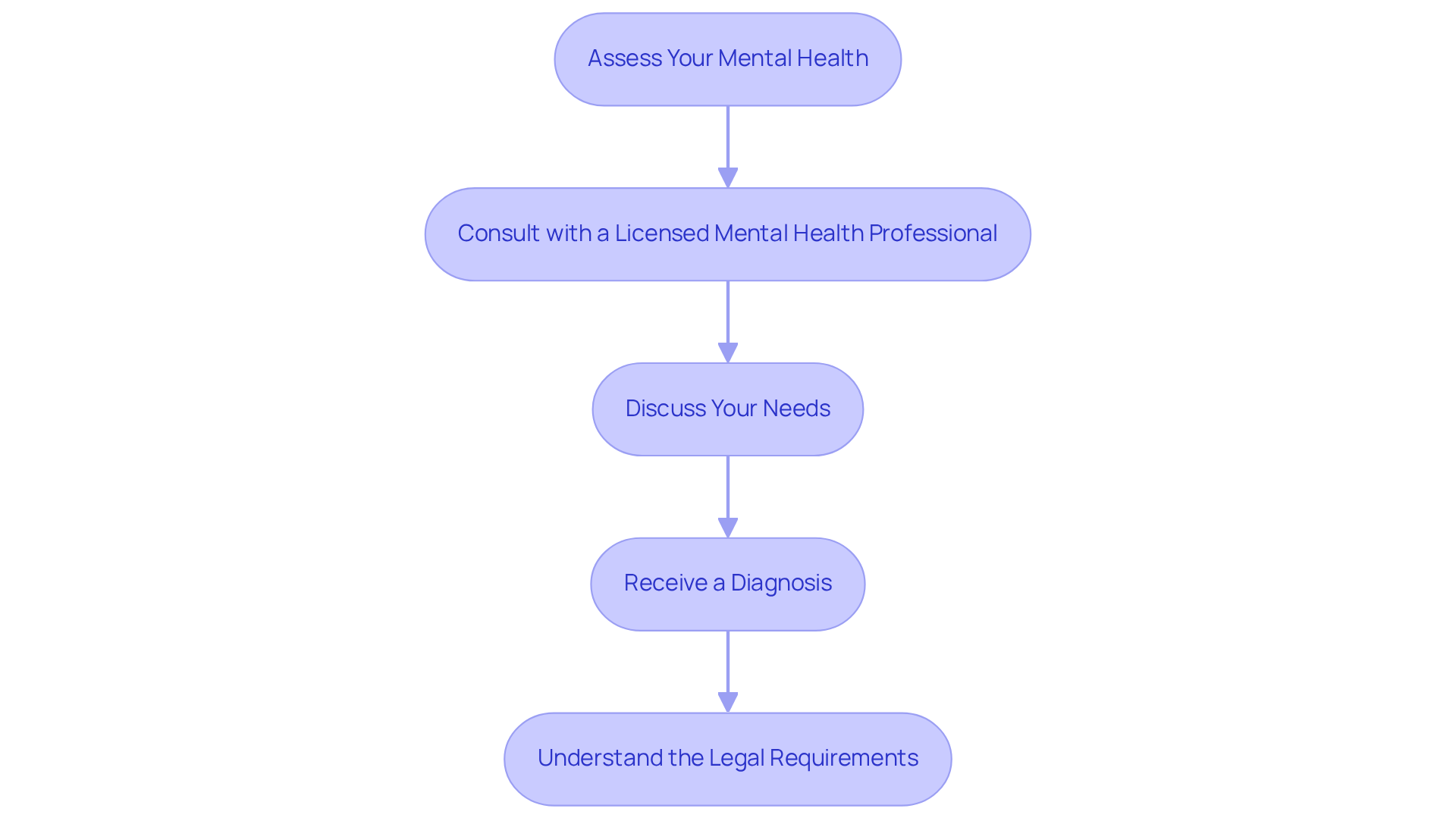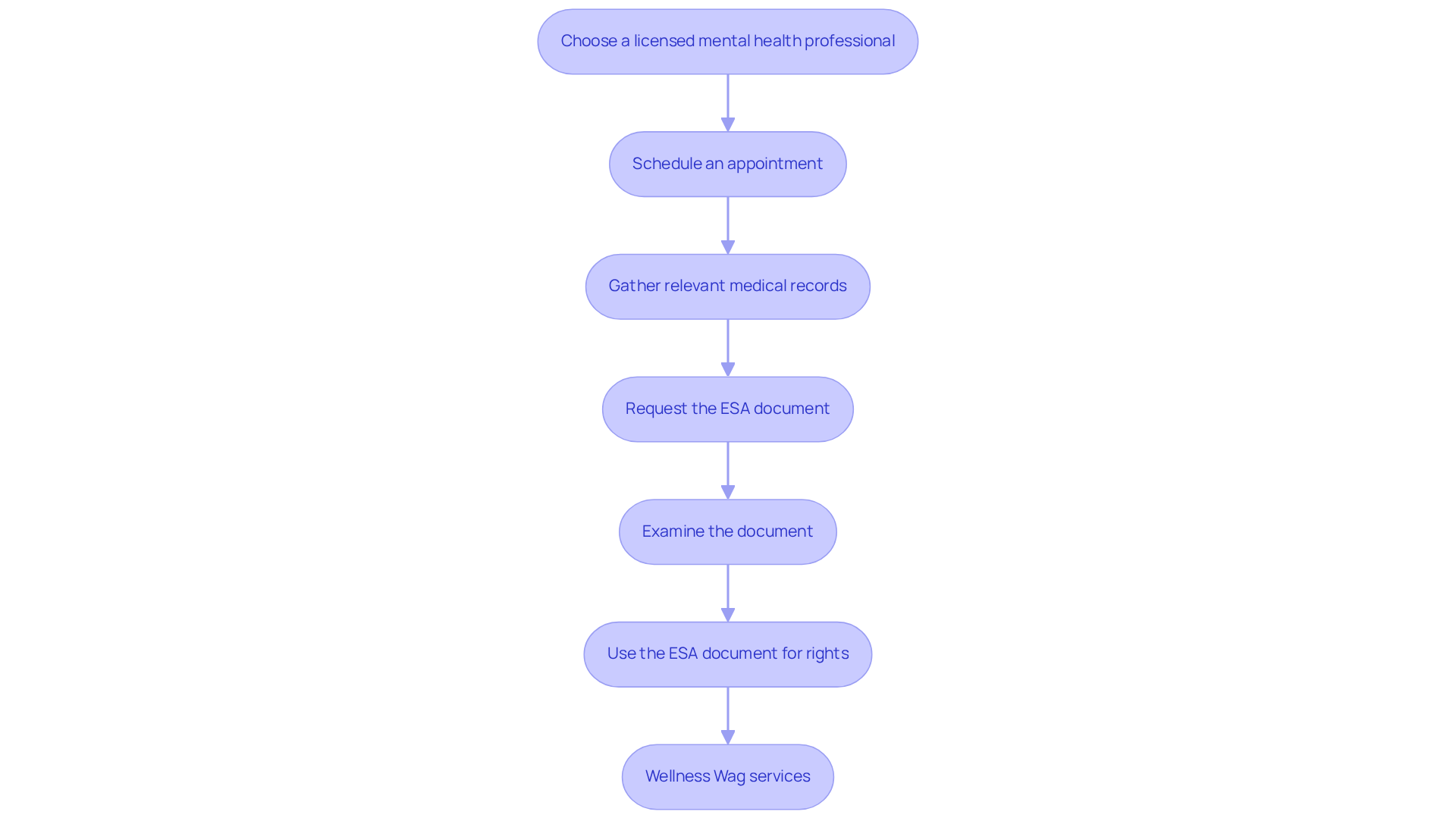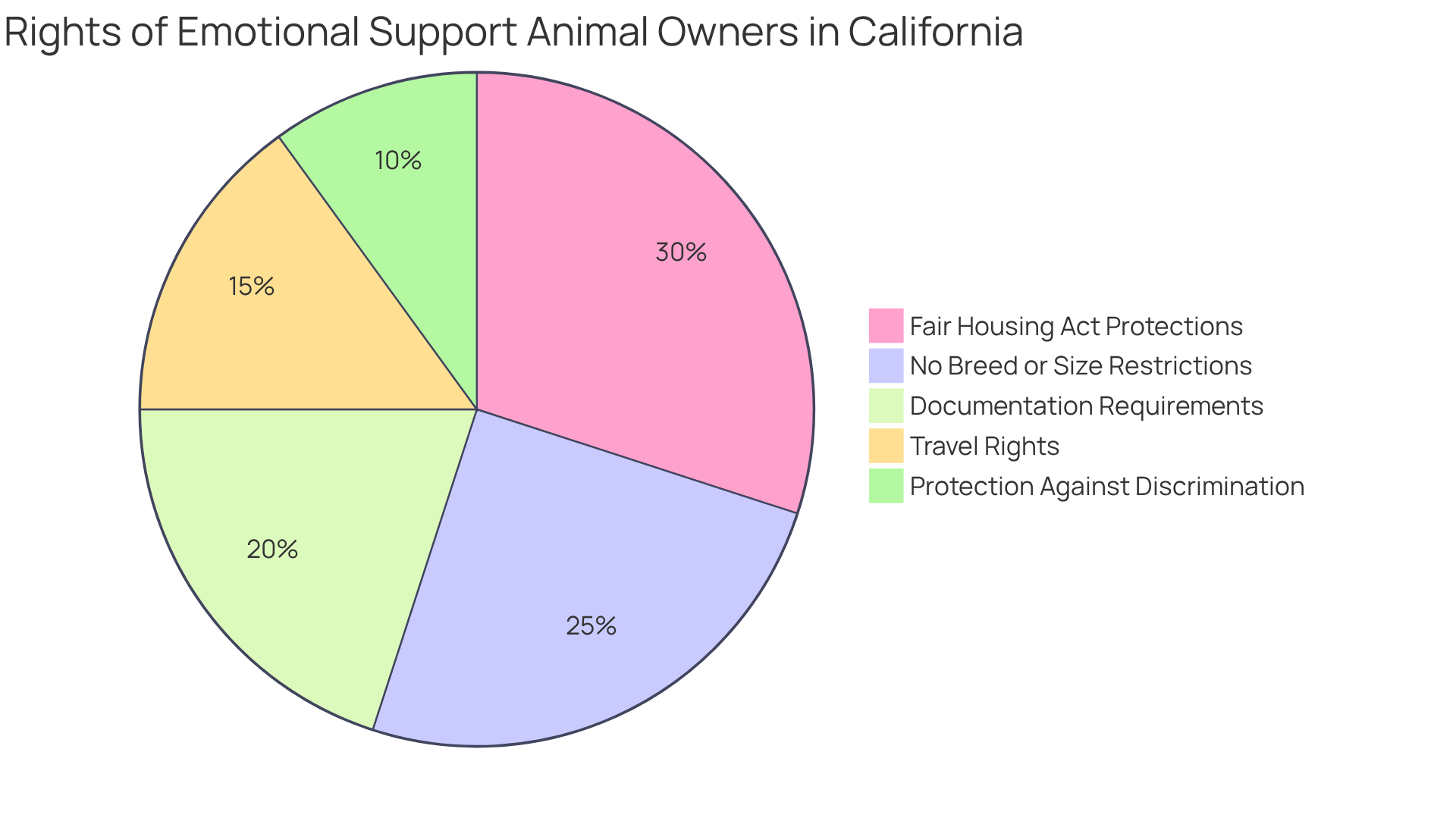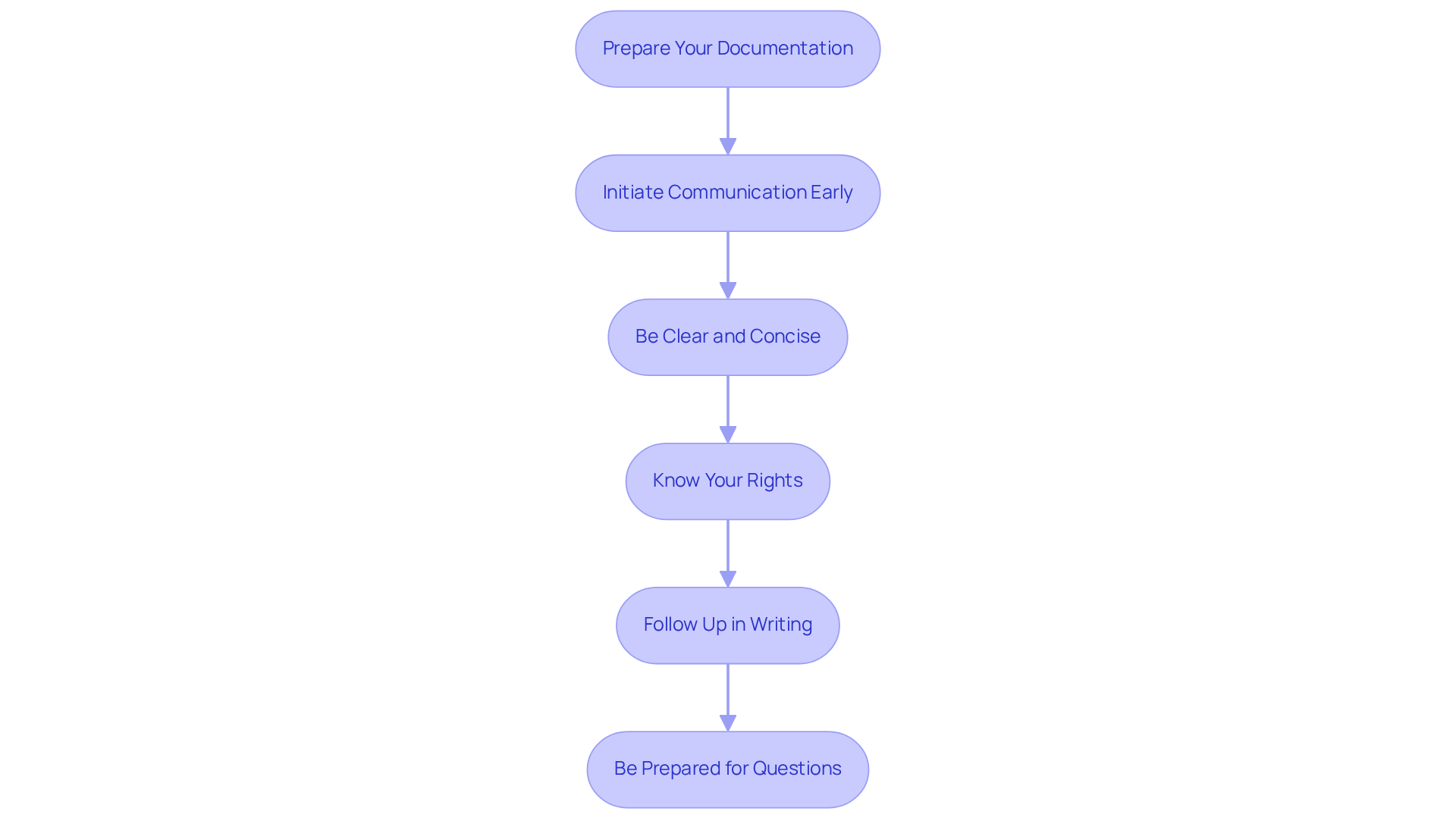

Emotional Support Animal Certification California: Step-by-Step Guide
by Lena Park
Last updated: July 6, 2025
Verified and Approved by:
Angela Morris,
MSW, LCSW
Fact Checked

Overview
This article offers a compassionate step-by-step guide for obtaining emotional support animal (ESA) certification in California. It outlines the essential eligibility criteria and the legal rights associated with ESAs, recognizing the emotional challenges that individuals with mental health issues often face.
- Consulting a licensed mental health professional is crucial.
- Obtaining a valid ESA letter, which can serve as a lifeline for those in need, is important.
- Understanding your rights under California law is equally important, ensuring that you can navigate the certification process with confidence and advocate for your emotional support needs.
Remember, you are not alone in this journey, and there is support available to help you every step of the way.
Introduction
Navigating the path to emotional support animal (ESA) certification in California can indeed feel both rewarding and overwhelming. For millions grappling with mental health challenges, the longing for companionship and relief has never been more significant. Support animals can provide a profound sense of comfort, helping individuals find solace during difficult times.
This guide aims to gently walk you through the essential steps to:
- Determine your eligibility
- Obtain the necessary documentation
- Understand the rights associated with ESAs
It is designed to empower you to advocate for your mental well-being. However, it’s important to consider: what happens when the very systems intended to provide support become obstacles in your journey?
Determine Your Eligibility for an Emotional Support Animal
To determine your eligibility for an Emotional Support Animal (ESA), please consider the following steps, designed to support you on this journey:
- Assess Your Mental Health: Take a moment to reflect on your emotional and psychological well-being. Many individuals face challenges such as anxiety, depression, and PTSD. In fact, studies show that about 25% of ESA owners experience major depression, while 29% have PTSD. Acknowledging these feelings is the first step towards healing.
- Consult with a Licensed Mental Health Professional (LMHP): It’s important to schedule an appointment with a licensed therapist, psychologist, or psychiatrist. California law mandates a minimum 30-day relationship with your LMHP before they can issue an emotional support animal certification California. This ensures they fully understand your mental wellness needs, creating a foundation of trust and support.
- Discuss Your Needs: During your consultation, openly share your mental well-being challenges and how an ESA might assist in your treatment. Be ready to discuss your symptoms and their impact on your daily life. Mental health professionals emphasize the importance of this dialogue, as it plays a crucial role in assessing the necessity of an ESA.
- Receive a Diagnosis: If your LMHP determines that you have a qualifying condition, they will provide a diagnosis that supports your need for an ESA. This diagnosis is essential for obtaining a legitimate ESA document, which can be a significant step towards your healing journey.
- Understand the legal requirements for emotional support animal certification California by familiarizing yourself with the state’s laws regarding ESAs, including the necessity of a valid ESA document from a licensed professional. This document is vital for accessing housing and travel accommodations under the Fair Housing Act and Air Carrier Access Act, ensuring you have the support you need in various aspects of life.
By following these steps, you can confidently assess your eligibility for an ESA and prepare for the next steps in the certification process. Remember, you are not alone on this journey, and there is support available to help you every step of the way.

Obtain an ESA Letter from a Licensed Professional
Navigating the process of obtaining your ESA letter can feel overwhelming, especially when you’re facing emotional challenges. Here’s a compassionate guide to help you through the necessary steps:
- Choose a licensed mental health professional who truly understands the therapeutic benefits of emotional support animals (ESAs). Finding a qualified LMHP can be done through online directories or by reaching out to local mental wellness services.
- Schedule an appointment with your chosen LMHP. In California, it’s important to establish a therapeutic relationship for at least 30 days before you can request an emotional support animal certification California document. This step is crucial for your emotional well-being.
- As you prepare for your appointment, gather relevant medical records and documentation that support your case. Think about your mental health history and how an ESA could positively impact your life. Being ready to discuss these aspects can foster a deeper understanding with your LMHP.
- When you feel comfortable, request the ESA document. If your LMHP agrees that an ESA is beneficial for your treatment, kindly ask for the official letter. This document should be on official letterhead, including the LMHP’s license number and signature, to ensure its validity.
- After receiving your document, examine it carefully. Make sure it clearly states your need for an emotional support animal certification California and complies with California regulations, emphasizing that the animal is essential for your emotional support.
- With your ESA document in hand, you can confidently use it for housing and travel arrangements, knowing your rights under the Fair Housing Act and Air Carrier Access Act are protected. However, it’s important to be aware that Air Canada no longer recognizes emotional support animals. If you plan to travel with a psychiatric service dog, you will need to complete a U.S. DOT Service Animal Air Transportation Form. This form requires vaccination details and certification that your service dog is trained to behave appropriately in public, will not relieve itself on the airplane, and that you accept responsibility for any damages caused by the animal.
- Wellness Wag provides ESA documents within 24 hours after approval, with costs ranging from $100 to $600, and offers flexible payment plans starting as low as $32.25. They also include a money-back guarantee, reinforcing customer satisfaction and confidence in their services. Remember, you are not alone in this journey, and support is available to help you every step of the way.

Understand Your Rights Under California ESA Laws
Understanding your rights as an ESA owner in California, particularly in relation to emotional support animal certification California, is crucial when navigating the emotional landscape that comes with mental health challenges. Here are some key aspects to consider:
- The Fair Housing Act Protections serve as a vital support for you. This act ensures that you can live with your ESA in properties that usually prohibit pets. It’s comforting to know that landlords cannot deny your request solely because of your ESA, acknowledging the importance of your mental well-being.
- Moreover, there are no breed or size restrictions. California law explicitly prevents landlords from enforcing limitations on the breed, size, or weight of ESAs. This flexibility allows you to choose any type of animal that qualifies as an ESA, making it easier to find a companion who resonates with your needs.
- When it comes to documentation requirements, it’s essential to present your emotional support animal certification California letter to landlords or housing providers. This letter must be current and issued by a licensed mental health professional, serving as official evidence for your emotional support animal certification in California. Having this documentation can alleviate some stress in your housing situation.
- Regarding travel rights, while ESAs do not have the same access as service animals, you may still travel with your ESA under certain conditions. It’s wise to check with airlines about their specific policies on ESAs, as these can vary significantly, ensuring you’re well-prepared for your journey.
- Finally, remember that you have protection against discrimination. If you face any discrimination related to your ESA, you have the right to file a complaint with the appropriate housing authority or seek legal assistance. In California, around 30% of ESA owners have reported experiencing discrimination, which underscores the importance of knowing your rights and advocating for them.
By familiarizing yourself with these rights, you can navigate housing and travel situations more effectively, ensuring that your emotional support needs are met and that you feel empowered in your journey.

Communicate Your ESA Needs to Landlords and Airlines
To effectively communicate your ESA needs, it’s important to approach the process with care and understanding. Here are some steps to help you navigate this journey:
- Prepare Your Documentation: Before reaching out to landlords or airlines, make sure your ESA documentation is at hand. This letter should express not just your need for the animal, but also the emotional support it provides you.
- Initiate Communication Early: It’s beneficial to contact your landlord or airline well ahead of your move or travel date. This gives you both ample time for open discussions and the necessary accommodations.
- Be Clear and Concise: When sharing your situation, be straightforward about your ESA requirement. A brief overview of your mental health condition and how your animal supports your well-being can foster understanding.
- Know Your Rights: Familiarizing yourself with your rights under California law and the Fair Housing Act is crucial. These laws mandate reasonable accommodations for individuals with disabilities, empowering you to advocate effectively for your needs.
- Follow Up in Writing: After your initial conversation, consider sending a follow-up email that summarizes your discussion and reiterates your request. This written record can be invaluable if any issues arise later.
- Be Prepared for Questions: It’s natural for landlords and airline representatives to have questions about your ESA. Be ready to provide additional information or clarification, reinforcing the legitimacy of your request.
By following these steps, you can ensure that your needs as an ESA owner are communicated effectively, leading to a more positive experience. In California, approximately 70% of property owners recognize the importance of allowing emotional support animal certification California, reflecting a growing awareness of their role in promoting mental well-being. Advocating for your rights is essential, as mental health professionals consistently highlight the significance of emotional support animal certification California in enhancing overall well-being.

Conclusion
Understanding the process of obtaining an Emotional Support Animal (ESA) certification in California is not just a procedural step; it’s a vital journey toward enhancing mental well-being through the companionship of a beloved pet. This journey begins with:
- Assessing personal eligibility
- Consulting with a licensed mental health professional
- Recognizing the legal protections that come with being an ESA owner
Each step is crucial, contributing not only to securing the necessary documentation but also to creating a nurturing environment for mental health recovery.
Throughout this exploration, we must emphasize the importance of:
- Open and thorough communication with mental health professionals
- Communication with landlords
- Communication with airlines
From evaluating mental health conditions to understanding rights under California law, every aspect is essential in empowering individuals to advocate for their needs effectively. This process is designed to support ESA owners, helping them navigate the complexities of housing and travel while maintaining the emotional support they require.
Ultimately, the significance of emotional support animals cannot be overstated. They are not merely pets; they play a vital role in the lives of many individuals facing mental health challenges. By following the outlined steps and remaining informed about rights and responsibilities, ESA owners can cultivate a more supportive and understanding environment for themselves and their cherished companions. Advocating for personal needs and comprehending the legal framework surrounding emotional support animals is not just about compliance; it is a fundamental aspect of the journey toward healing and well-being.
Frequently Asked Questions
What is an Emotional Support Animal (ESA)?
An Emotional Support Animal (ESA) is a pet that provides comfort and support to individuals facing emotional or psychological challenges.
How can I determine my eligibility for an ESA?
To determine your eligibility for an ESA, assess your mental health, consult with a licensed mental health professional (LMHP), discuss your needs, receive a diagnosis, and understand the legal requirements for ESA certification.
What should I assess about my mental health?
Reflect on your emotional and psychological well-being, considering challenges such as anxiety, depression, and PTSD. Acknowledging these feelings is the first step toward healing.
Why is it important to consult with a licensed mental health professional?
Consulting with an LMHP is crucial as California law requires a minimum 30-day relationship before they can issue an ESA certification. This ensures they understand your mental wellness needs.
What should I discuss with my LMHP during the consultation?
You should openly share your mental well-being challenges, how an ESA might assist in your treatment, your symptoms, and their impact on your daily life.
What happens if my LMHP determines I have a qualifying condition?
If your LMHP determines you have a qualifying condition, they will provide a diagnosis that supports your need for an ESA, which is essential for obtaining a legitimate ESA document.
What are the legal requirements for ESA certification in California?
Familiarize yourself with California’s laws regarding ESAs, including the requirement for a valid ESA document from a licensed professional, which is necessary for accessing housing and travel accommodations.
How does having an ESA benefit me legally?
A valid ESA document allows you to access housing and travel accommodations under the Fair Housing Act and Air Carrier Access Act, ensuring you have the necessary support in various aspects of life.
Certify Your Emotional Support Animal Today

Why You Can Rely on Us?
At Wellness Wag, we believe your pet deserves care rooted in both science and compassion. Each article is carefully researched, written in clear language for pet owners, and then reviewed by qualified professionals to ensure the information is evidence-based, current, and practical for real-life care. Our goal is to help you feel confident in making informed decisions about your pet’s health and well-being.
Reviewed by
Angela Morris, MSW, LCSW
Angela is a licensed clinical social worker with 20 years of experience in patient advocacy and community mental health. She has assisted numerous clients with ESA evaluations and brings a deep understanding of disability accommodations, ensuring that all information is accurate, supportive, and practical.

Written by :
Lena Park
Last Updated :
July 6, 2025












